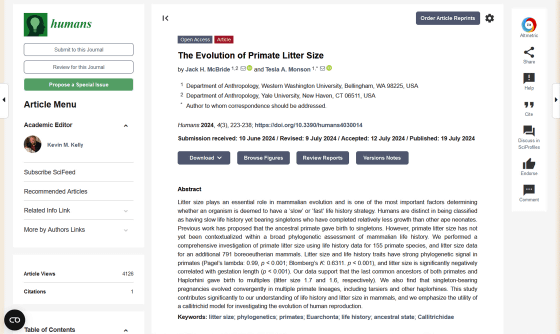Why are there so few twins in humans when twins were common in our primate ancestors?

Although twins are rare in human society, and non-human primates usually only give birth to one baby per litter, a new study from the United States has shown that twins were not uncommon in the common ancestor of humans and primates.
The Evolution of Primate Litter Size

Twins were the norm for our ancient primate ancestors − one baby at a time had evolutionary advantages
https://theconversation.com/twins-were-the-norm-for-our-ancient-primate-ancestors-one-baby-at-a-time-had-evolutionary-advantages-237420
Primates living today, with the exception of some species such as marmosets , tamarins , and lemurs , generally give birth to one baby per pregnancy. The rate of twin births in humans is about 1.1-1.5%, and although the rate of twin births has increased in some areas in recent years due to advances in assisted reproductive technology, twins and triplets are still extremely rare.
Tesla Monson , an associate professor of anthropology at Western Washington University in the United States, and her team have been studying the evolution of the number of children that primates conceive at one time (liter size). To reconstruct the history of primate liter size, the team collected data on liter sizes for a total of 946 mammal species, including 155 primate species, and analyzed patterns using a mathematical algorithm.
Additionally, data on primates' life history, gestation period, maximum life span, age at maturity, birth and maturity weights, age at weaning, birth interval, and brain mass at birth and maturity were collected and included in the analysis.

The analysis showed that litter size in some species is phylogenetically conserved, with closely related species tending to have similar litter sizes: for example, deer give birth to one or two pups per pregnancy, while cats and canines tend to have larger litters at one time.
Many evolutionary biologists have thought that it is common for primates to give birth to one baby per pregnancy, and that species that give birth to twins or more, such as marmosets and tamarins, are derived species. However, this study found that 'primates that give birth to only one baby per pregnancy are the ones that derived from the ancestors.' In other words, it was common for the ancestors of primates to give birth to two babies per pregnancy, and many primates, including humans, derived from them to give birth to only one baby.
Based on mathematical modeling, the switch from twin births to single births in primates appears to have occurred at least 50 million years ago. Furthermore, the switch from twin births to single births appears to have occurred multiple times within the primate lineage, suggesting that there may have been some evolutionary advantage to giving birth to only one baby per pregnancy in primates.
It is thought that the reason why primates began to give birth to one baby per pregnancy may be due to the 'increased head size relative to the body.' Humans' larger brains lead to the ability to create useful technologies and pass on culture. However, when giving birth to multiple babies at the same time, each baby tends to be smaller and born earlier, so it may have been advantageous for survival to give birth to only one large baby.

Related Posts:







